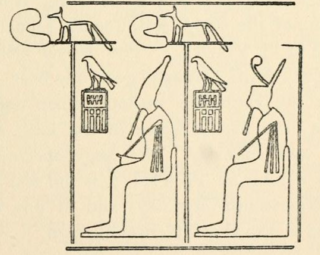
Djer is considered the third pharaoh of the First Dynasty of ancient Egypt in current Egyptology. He lived around the mid 31st century BC and reigned for c. 40 years. A mummified forearm of Djer or his wife was discovered by Egyptologist Flinders Petrie, but was discarded by Émile Brugsch.

Merneith was a consort and a regent of Ancient Egypt during the First Dynasty. She may have been a ruler of Egypt in her own right, based on several official records. If this was the case and the earlier royal wife Neithhotep never ruled as an independent regent, Merneith may have been the first female pharaoh and the earliest queen regnant in recorded history. Her rule occurred around 2950 BC for an undetermined period. Merneith’s name means "Beloved by Neith" and her stele contains symbols of that ancient Egyptian deity. She may have been Djer's daughter and was probably Djet's senior royal wife. The former meant that she would have been the great-granddaughter of unified Egypt's first pharaoh, Narmer. She was also the mother of Den, her successor.

Mutnedjmet, also spelled Mutnodjmet, Mutnedjemet, etc., was an ancient Egyptian queen, the Great Royal Wife of Horemheb, the last ruler of the 18th Dynasty. The name, Mutnedjmet, translates as: "The sweet Mut" or "Mut is sweet."

Nimaathap was an ancient Egyptian queen consort at the transition time from 2nd Dynasty to 3rd Dynasty. Nimaathap may have acted as regent for her son Djoser.
Iput I was a Queen of Egypt, a daughter of King Unas, the last king of the Fifth Dynasty of Egypt. She married Teti, the first Pharaoh of the Sixth Dynasty of Egypt. Their son was Pepi I Meryre. She possibly ruled as regent for her son Pepi I.

Neithhotep or Neith-hotep was an ancient Egyptian queen consort who lived and ruled during the early First Dynasty. She was once thought to be a male ruler: her outstandingly large mastaba and the royal serekh surrounding her name on several seal impressions previously led Egyptologists and historians to the erroneous belief that she might have been an unknown king. As the understanding of early Egyptian writings developed, scholars learned that Neithhotep was in fact a woman of extraordinary rank. She was subsequently considered to be the wife of unified Egypt's first pharaoh, Narmer, and the mother of Hor-Aha.
Meritites I was an ancient Egyptian queen of the 4th Dynasty. Her name means "Beloved of her Father". Several of her titles are known from a stela found at Giza. She was buried in the middle Queen’s Pyramid in Giza.
Khuit II was a wife of King Teti, the first pharaoh of the Sixth Dynasty of Egypt.
Seshemetka was an ancient Egyptian queen from the First Dynasty of Egypt, a wife of pharaoh Den and the mother of Anedjib. Her royal titles were Great one of the hetes-sceptre , She who sees Horus , She who carries Seth .

Meresankh IV was a queen of Egypt in the 5th Dynasty. Her name means "she loves life". While some sources consider that her husband is unknown, other sources suggest her husband was Pharaoh Menkauhor Kaiu. It is also possible that Meresankh was the wife of Djedkare Isesi.
Khuit I was an Egyptian queen who lived in the mid-5th Dynasty of Egypt.

Benerib was a queen consort of ancient Egypt from First Dynasty. Benerib's name means "sweet(bene) of heart(ib)".
Khenthap was allegedly a queen of Ancient Egypt. She is said to have lived during the 1st Dynasty. Her historical figure is very obscure, since there are no contemporary sources for her name. She appears only once in a much later inscription.
Persenet was an ancient Egyptian queen consort of the 4th Dynasty. She may have been a daughter of King Khufu and a wife of King Khafre. She is mainly known from her tomb at Giza.
Reptynub was a Queen during the Fifth Dynasty of Egypt. She was the wife of King Nyuserre Ini. She was possibly a mother of Menkauhor Kaiu.
Nebet was an Egyptian Queen, the wife of King Unas. She lived during the time of the Fifth Dynasty of Egypt. She is held the mother of the Crown Prince Unas-ankh, though this fact is disputed. In addition to Unas Anch, Nebet may also be the mother of Khentkaues, Neferut, and Nefertkaues.
Khenut was the Queen of Egypt, the wife of King Unas. She lived during the time of the Fifth Dynasty of Egypt. She was a suspected mother of Queen Iput.
Nakhtubasterau (Nakhtbastetiru) was the Great Royal Wife of Amasis II. She dates to the Twenty-sixth Dynasty of Egypt. Her name honors Bastet.

Mastaba S3503 is a large mastaba tomb at the Saqqara necropolis in Lower Egypt. The burial was constructed around 3000 BC during the 1st Dynasty of Ancient Egypt.








